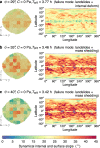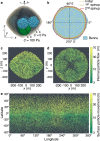Inferring interiors and structural history of top-shaped asteroids from external properties of asteroid (101955) Bennu
- PMID: 35933392
- PMCID: PMC9357032
- DOI: 10.1038/s41467-022-32288-y
Inferring interiors and structural history of top-shaped asteroids from external properties of asteroid (101955) Bennu
Abstract
Asteroid interiors play a key role in our understanding of asteroid formation and evolution. As no direct interior probing has been done yet, characterisation of asteroids' interiors relies on interpretations of external properties. Here we show, by numerical simulations, that the top-shaped rubble-pile asteroid (101955) Bennu's geophysical response to spinup is highly sensitive to its material strength. This allows us to infer Bennu's interior properties and provide general implications for top-shaped rubble piles' structural evolution. We find that low-cohesion (≲0.78 Pa at surface and ≲1.3 Pa inside) and low-friction (friction angle ≲ 35∘) structures with several high-cohesion internal zones can consistently account for all the known geophysical characteristics of Bennu and explain the absence of moons. Furthermore, we reveal the underlying mechanisms that lead to different failure behaviours and identify the reconfiguration pathways of top-shaped asteroids as functions of their structural properties that either facilitate or prevent the formation of moons.
© 2022. The Author(s).
Conflict of interest statement
The authors declare no competing interests.
Figures





References
-
- Walsh KJ. Rubble pile asteroids. Annu. Rev. Astron. Astrophys. 2018;56:593–624. doi: 10.1146/annurev-astro-081817-052013. - DOI
-
- Margot, J. L., Pravec, P., Taylor, P., Carry, B. & Jacobson, S. in Asteroids IV (eds Michel, P., DeMeo, F. E. & Bottke, W. F.) 355–374 (Univ. of Arizona Press, 2015).
-
- Rubincam DP. Radiative spin-up and spin-down of small asteroids. Icarus. 2000;148:2–11. doi: 10.1006/icar.2000.6485. - DOI
-
- Harris AW, Fahnestock EG, Pravec P. On the shapes and spins of "rubble pile” asteroids. Icarus. 2009;199:310–318. doi: 10.1016/j.icarus.2008.09.012. - DOI
LinkOut - more resources
Full Text Sources
Research Materials

